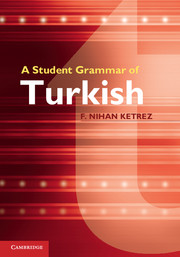Book contents
- Frontmatter
- Contents
- Acknowledgments
- Conventions used in the book
- Chapter 1 Introduction
- Chapter 2 The sounds of Turkish
- Chapter 3 The noun: an overview
- Chapter 4 Case markers
- Chapter 5 Genitive and possessive
- Chapter 6 Numerals and plurality
- Chapter 7 Existential var / yok
- Chapter 8 Pronouns
- Chapter 9 The verb: an overview
- Chapter 10 -Iyor, the progressive
- Chapter 11 Future with -(y)AcAK
- Chapter 12 Past with -DI and -(y)DI
- Chapter 13 -mIş and -(y)mIş
- Chapter 14 Present tense with the aorist -Ir/-Ar
- Chapter 15 -mAktA and -DIr
- Chapter 16 Imperative and optative
- Chapter 17 Compound tenses
- Chapter 18 Person markers
- Chapter 19 Postpositions
- Chapter 20 Passive
- Chapter 21 Causative
- Chapter 22 Reflexive
- Chapter 23 Reciprocal
- Chapter 24 Subordination
- Chapter 25 Infinitives with -mA and -mAK
- Chapter 26 Adjectives
- Chapter 27 Adverbials
- Chapter 28 Conditional
- Chapter 29 Ability and possibility with -(y)Abil
- Chapter 30 Obligation and necessity
- Chapter 31 Relative clauses
- Chapter 32 Word order
- Chapter 33 Questions
- Chapter 34 Negation
- Chapter 35 Coordination
- Chapter 36 Diminutive
- Chapter 37 Reduplication
- Chapter 38 Interjections and some idiomatic expressions
- Chapter 39 Spelling and punctuation
- Chapter 40 Conversation
- Appendix A Verbal inflection paradigms
- Appendix B Nominal inflection paradigms
- Appendix C Verbs categorized according to their case-marked complements
- Appendix D Verbs categorized according to their clausal complement types
- Appendix E Selected grammar books for further study
- Appendix F Answer key to the exercises
- Appendix G Glossary of grammatical terms
- Index
Chapter 29 - Ability and possibility with -(y)Abil
Published online by Cambridge University Press: 05 June 2012
- Frontmatter
- Contents
- Acknowledgments
- Conventions used in the book
- Chapter 1 Introduction
- Chapter 2 The sounds of Turkish
- Chapter 3 The noun: an overview
- Chapter 4 Case markers
- Chapter 5 Genitive and possessive
- Chapter 6 Numerals and plurality
- Chapter 7 Existential var / yok
- Chapter 8 Pronouns
- Chapter 9 The verb: an overview
- Chapter 10 -Iyor, the progressive
- Chapter 11 Future with -(y)AcAK
- Chapter 12 Past with -DI and -(y)DI
- Chapter 13 -mIş and -(y)mIş
- Chapter 14 Present tense with the aorist -Ir/-Ar
- Chapter 15 -mAktA and -DIr
- Chapter 16 Imperative and optative
- Chapter 17 Compound tenses
- Chapter 18 Person markers
- Chapter 19 Postpositions
- Chapter 20 Passive
- Chapter 21 Causative
- Chapter 22 Reflexive
- Chapter 23 Reciprocal
- Chapter 24 Subordination
- Chapter 25 Infinitives with -mA and -mAK
- Chapter 26 Adjectives
- Chapter 27 Adverbials
- Chapter 28 Conditional
- Chapter 29 Ability and possibility with -(y)Abil
- Chapter 30 Obligation and necessity
- Chapter 31 Relative clauses
- Chapter 32 Word order
- Chapter 33 Questions
- Chapter 34 Negation
- Chapter 35 Coordination
- Chapter 36 Diminutive
- Chapter 37 Reduplication
- Chapter 38 Interjections and some idiomatic expressions
- Chapter 39 Spelling and punctuation
- Chapter 40 Conversation
- Appendix A Verbal inflection paradigms
- Appendix B Nominal inflection paradigms
- Appendix C Verbs categorized according to their case-marked complements
- Appendix D Verbs categorized according to their clausal complement types
- Appendix E Selected grammar books for further study
- Appendix F Answer key to the exercises
- Appendix G Glossary of grammatical terms
- Index
Summary
-(y)Abil
Both ability (‘can’) and possibility (‘may’) are expressed with the suffix -(y)Abil in Turkish. The same suffix is used to express permission as well. When it is attached to verbs, the first vowel of the suffix undergoes vowel harmony, while the last syllable does not alternate: aç-abil-, iç-ebil-, dur-abil-, etc. The suffix is followed by tense, aspect, and person markers.
Sen çayı şekersiz içebilir misin?
Saat kaçta evde olabilirsiniz?
Yarınki toplantılara Hale Hanım da katılabilecek.
Burada oturabilir miyim?
In the affirmative sentences, the interpretation and ability-possibility distinction is determined by the context. Tense markers and person markers that are attached to the verb, because they are a part of the context, may give clues regarding the interpretation as well. For example, with the permission and possibility interpretations, usually the aorist (present tense) markers are used.
-(y)Abil is used to form polite requests as well. Using - (y)Abil together with the aorist makes the question more polite. The first example below sounds more polite than the second one without - (y)Abil:
Radyonun sesini biraz kısabilir misiniz?
Radyonun sesini biraz kısar mısınız?
- Type
- Chapter
- Information
- A Student Grammar of Turkish , pp. 213 - 216Publisher: Cambridge University PressPrint publication year: 2012



